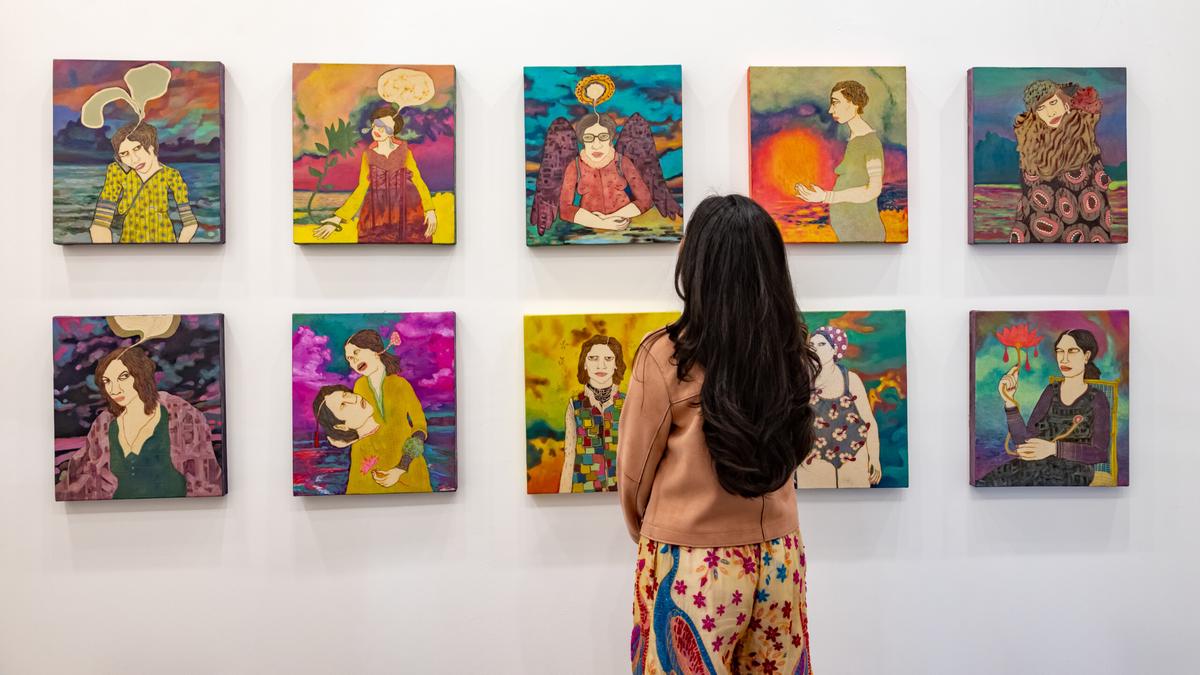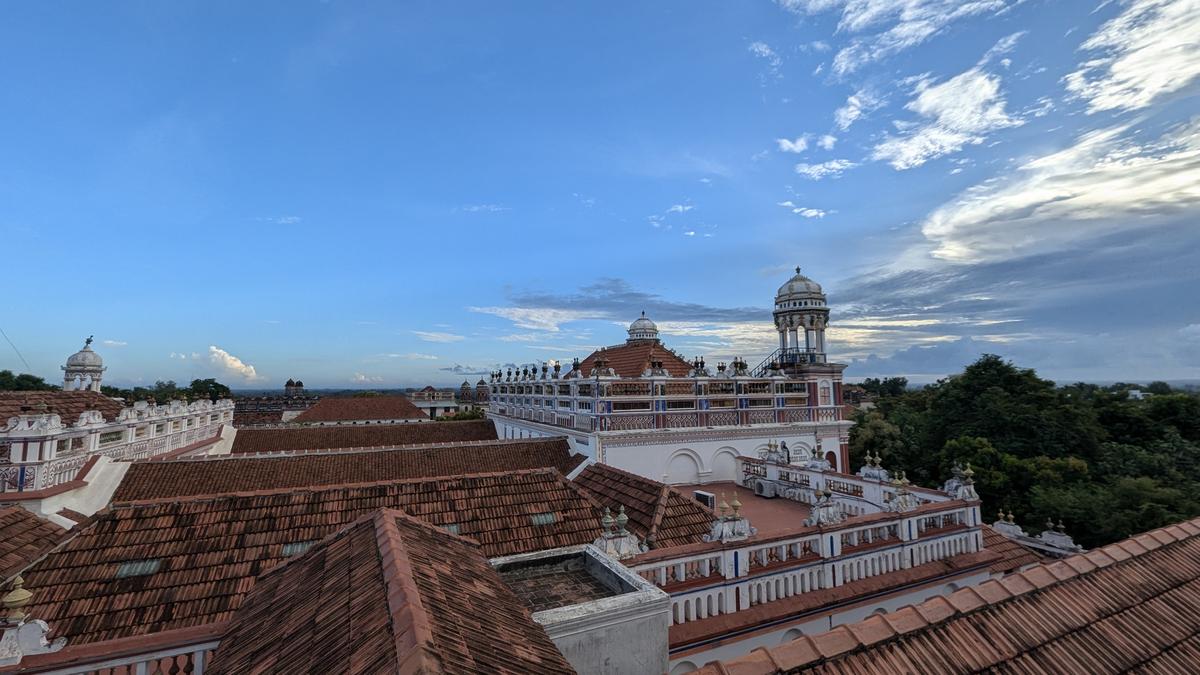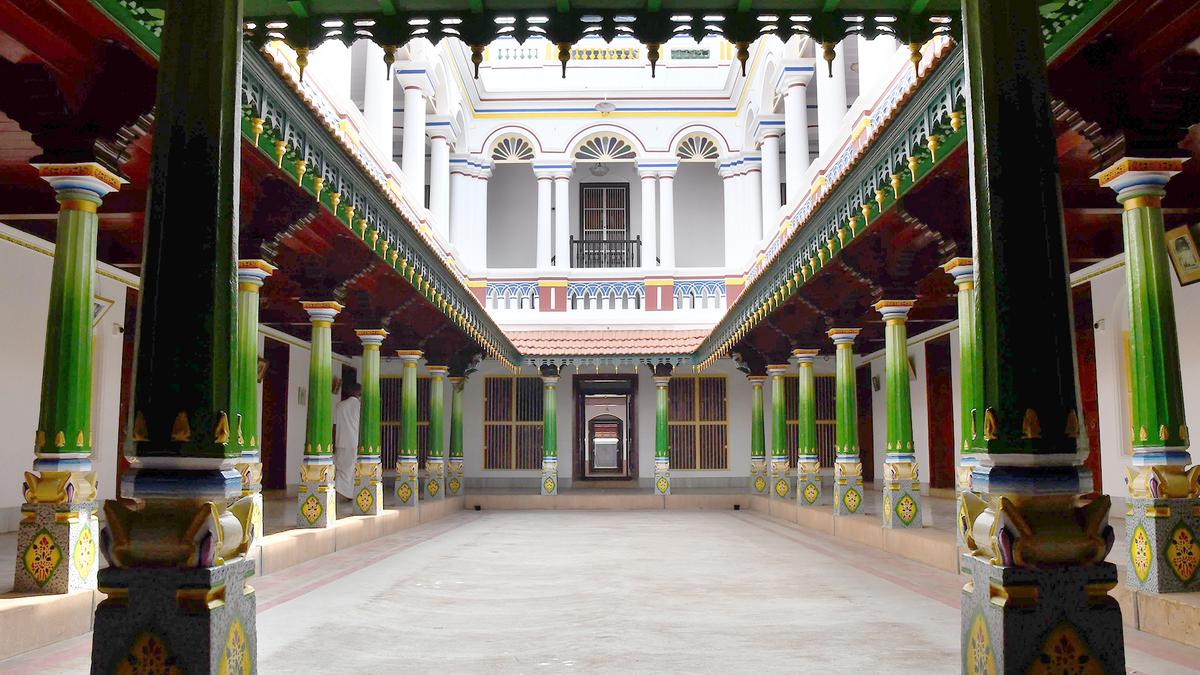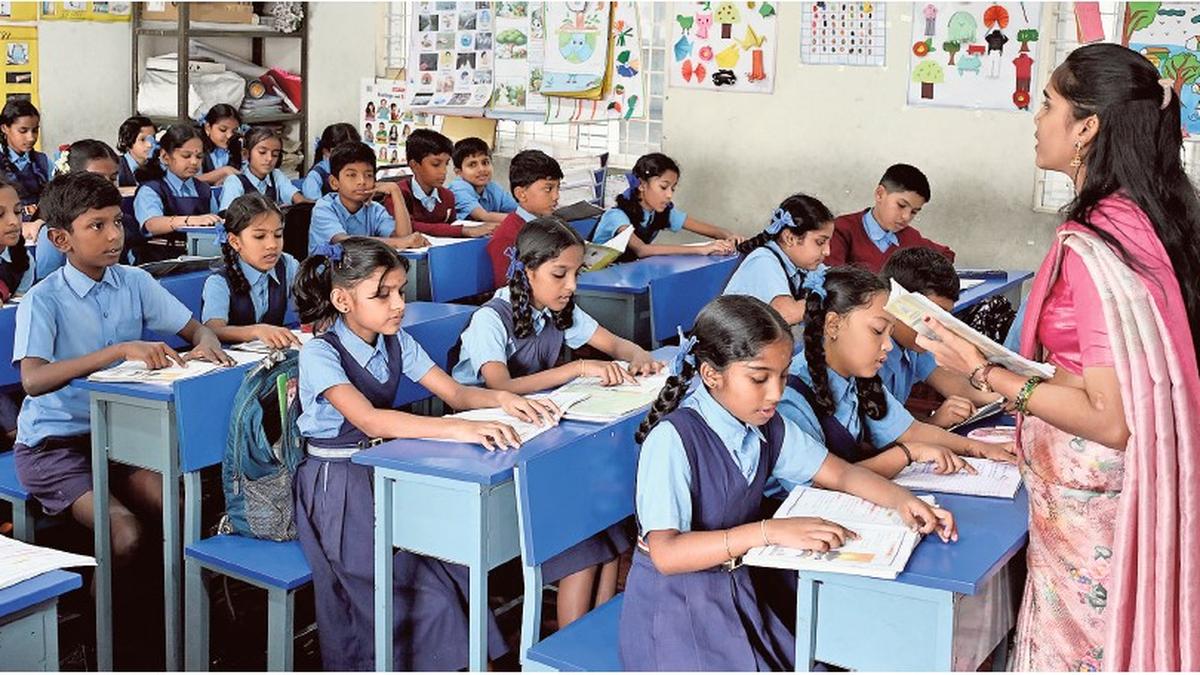Within six hours of day one at the India Art Fair, curator Alaiia Gujral has sold 10 pieces of the collectible design showcase ‘Shifting Horizons’. In the dimly-lit, sparsely-decorated booth, she has brought together pieces by 17 emerging designers, including a fibre-board, teakwood and brass swing, natural dyed rattan and white ashwood stools, and a ceramics-based “illuminating sculpture”.
“Hopefully, a few more will go,” Gujral says with a little laugh, perched on designers Nitush and Aroosh’s Vidya Vrtta, a light installation made of stainless steel, faux fur and glass, taking a breather from answering questions from patrons, many curious about what furniture is doing at an art fair. “Art and design are always in conversation. I’ve been insistent on showcasing new designers and never-seen-before works by prominent ones. It’s affordable and we have a good range. It’s nice that you can own something different in your home.”
Shifting Horizons showcase
| Photo Credit:
Special arrangement
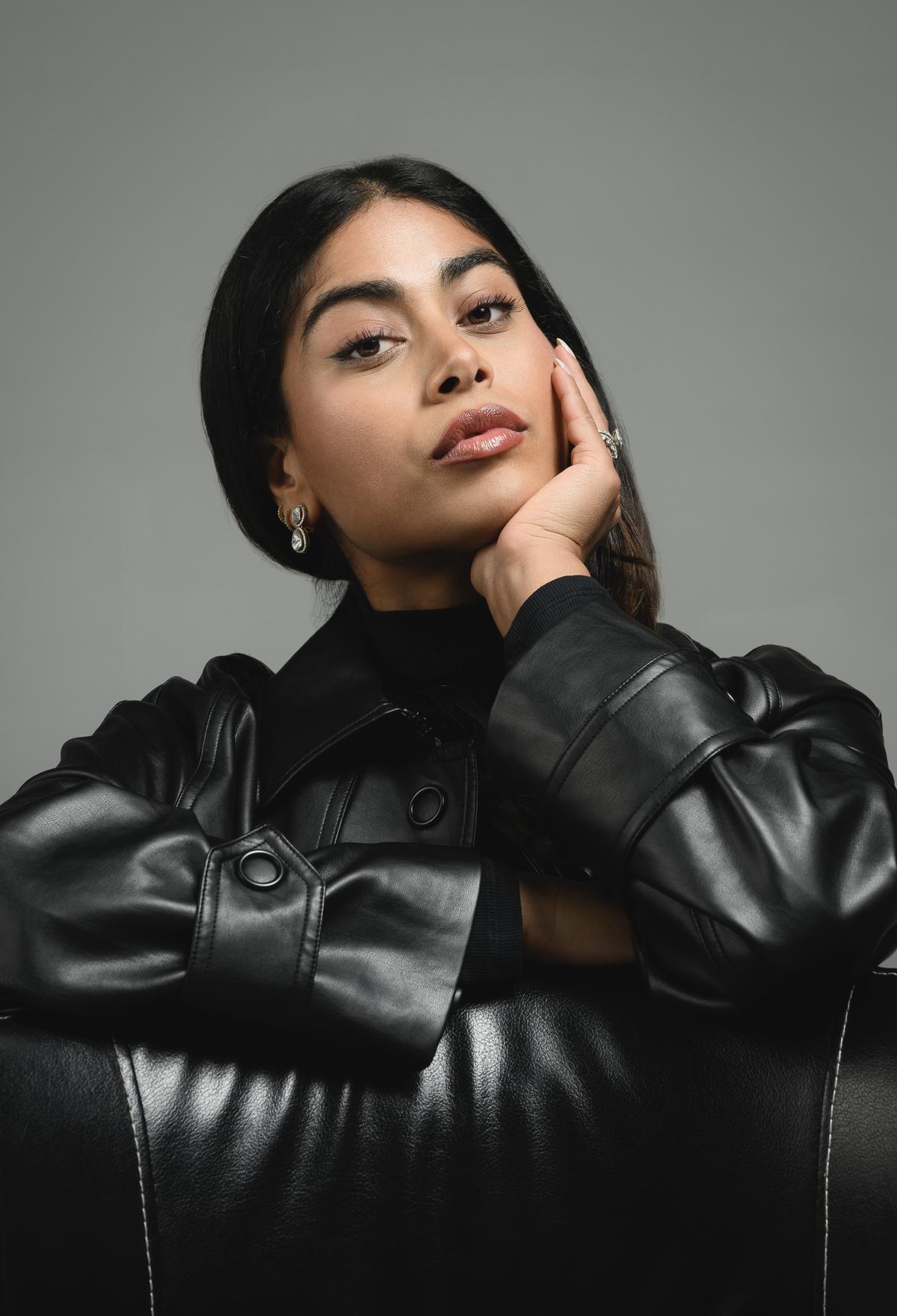
Alaiia Gujral
| Photo Credit:
Special arrangement
Elsewhere in the conjoined tents at Delhi’s NSIC Grounds — whose facade is struck through with artist Ayesha Singh’s minimal, monochrome artwork Skewed Histories and Site Lines — DAG’s multicoloured walls stand out against a sea of white, its booth abuzz with visitors. On display is a show titled ‘DAG Past and Present: 18th-21st century Modern Art’, in which Bengal wash style watercolours, mountain landscapes, Anglo-Indian art as well as Progressives and other modernists vie for attention. “It seems everyone wants to be at the art fair this year,” exclaims Ashish Anand, director of DAG. “The Indian art world has grown in volume and its discernment. Viewers, and collectors are now hungry for more discoveries.”
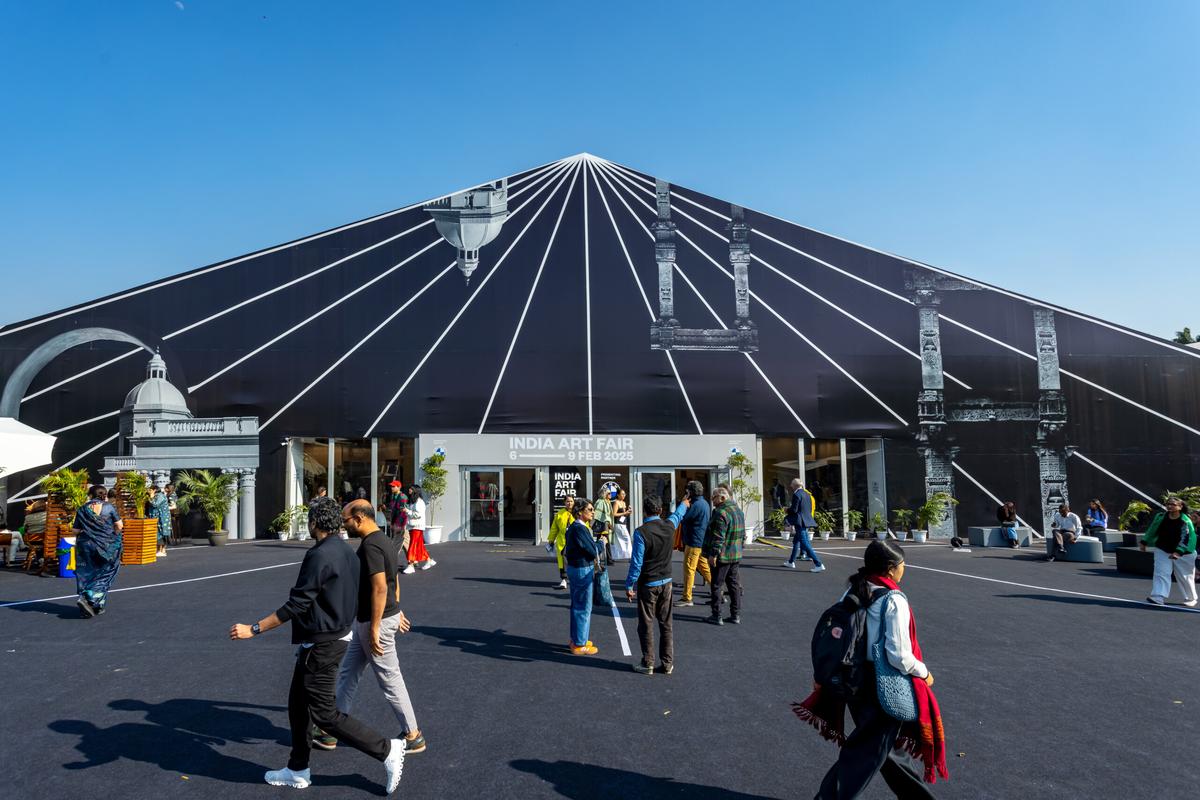
Artist Ayesha Singh’s minimal, monochrome artwork Skewed Histories and Site Lines
| Photo Credit:
Courtesy of India Art Fair
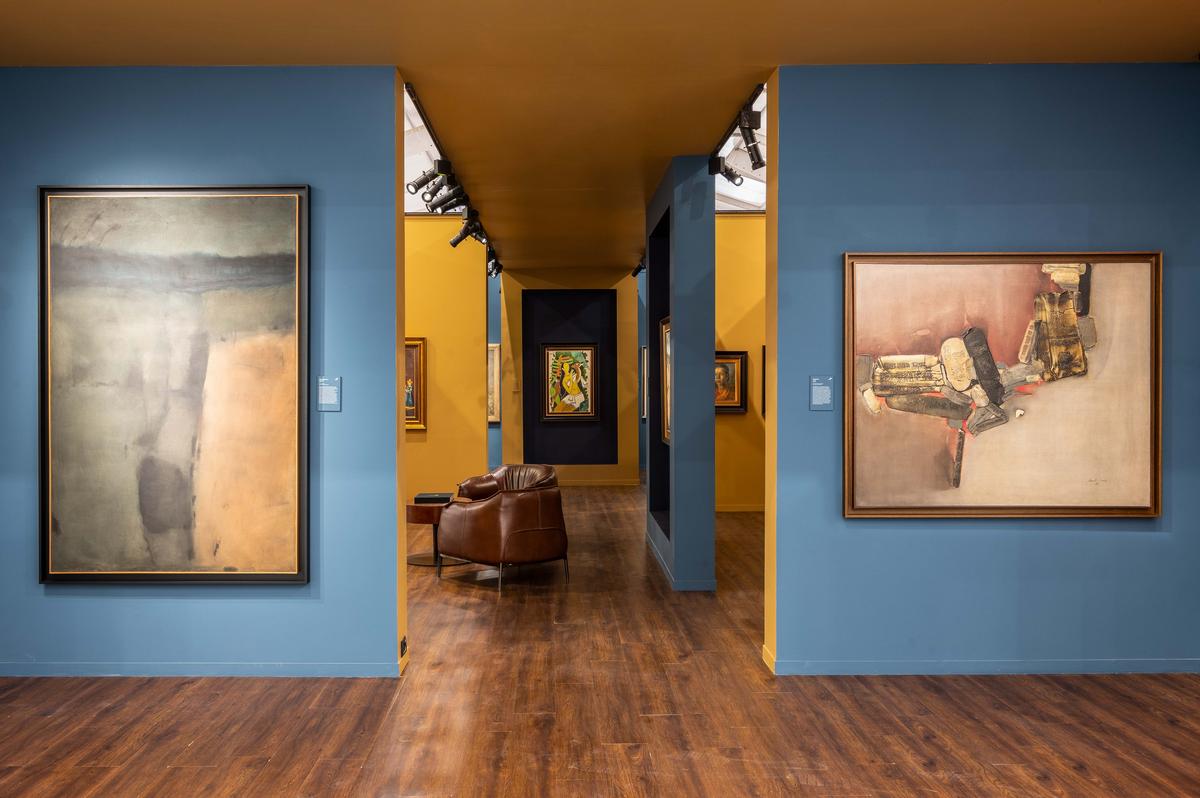
DAG’s multicoloured booth
| Photo Credit:
Special arrangement
In a third tent across the green carpeted path lined with makeshift cafes, a stage and outdoor art exhibits, hoards trip over themselves to giggle at the captions accompanying the textile-based works of Viraj Khanna and take selfies with the artist, who is also showing a new set of khakha-based portrait-like acrylic on paper paintings at his show Love Me, Love My Dog at Kalakriti Gallery. “There’s a young collector base that’s interested in buying my work,” observes the medium-agnostic artist. “A lot of people who travel and are seeing a lot of textile in international fairs — they are picking it up. Most of them are from Mumbai, I don’t know why. There’s also people who’ve worn our clothing [his mother Anamika Khanna’s designs] and they want to see what’s happening next.”
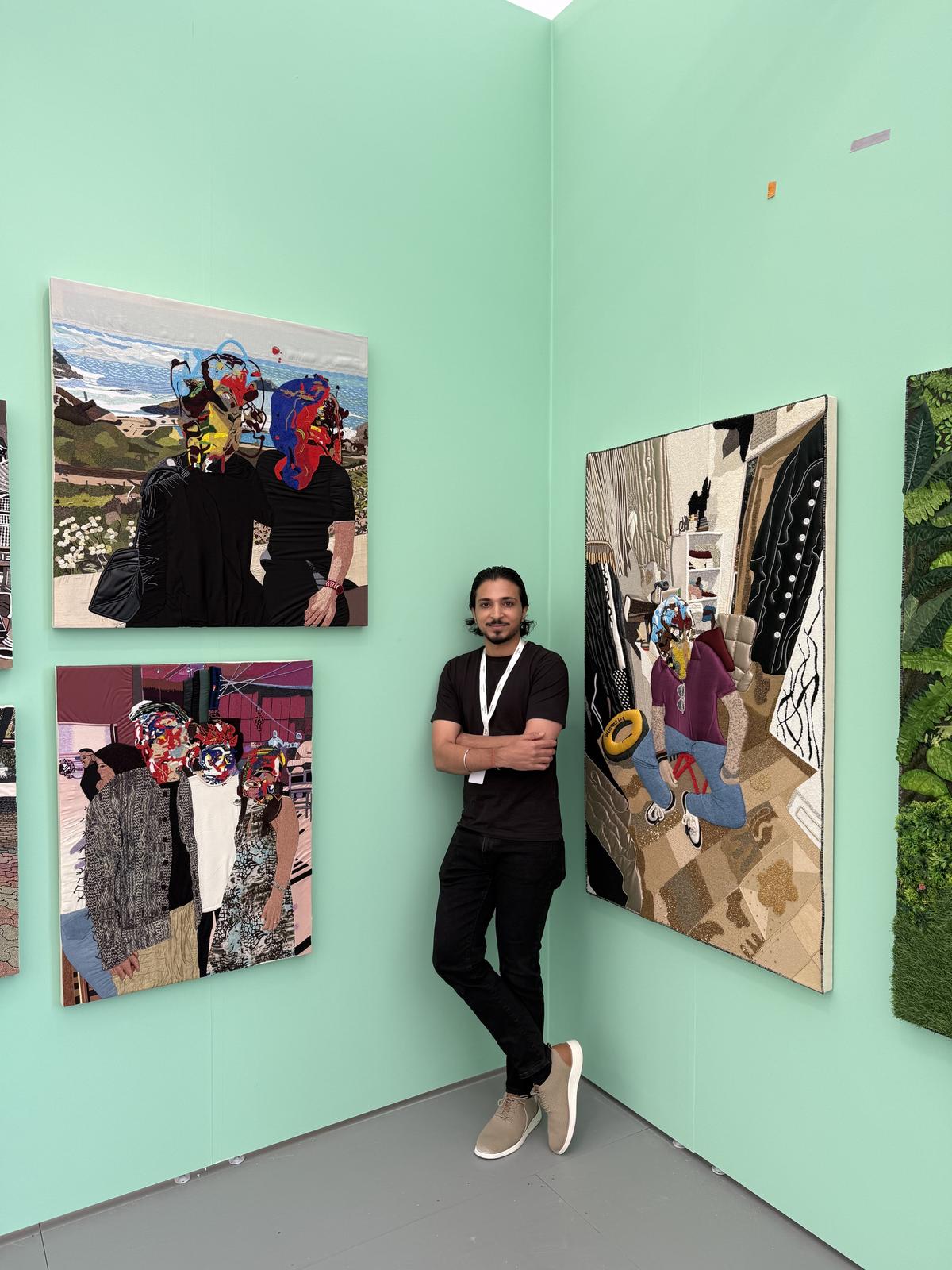
Viraj Khanna
| Photo Credit:
Special arrangement
A growing art market
For one weekend this month, a corner of New Delhi transforms into its own garden of earthly delights at the 16th edition of the annual India Art Fair (IAF), where art in all manner of shape, form, material, provenance, and pedigree takes centrestage. At its largest edition yet, 120 Indian and international exhibitors show classical, modern and contemporary art — by the superstars, the usual suspects and emerging artists from around the world.
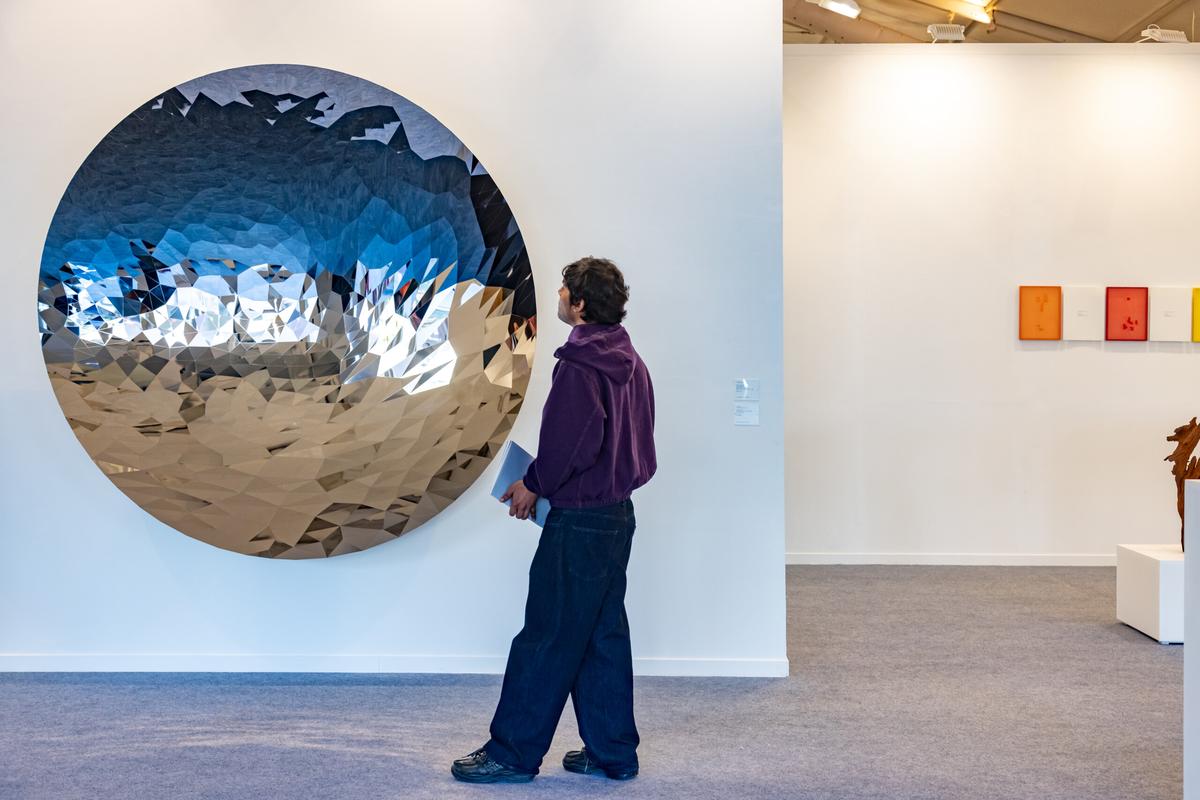
A visitor at London’s Lisson Gallery booth
| Photo Credit:
Courtesy of India Art Fair
It also spills out into a larger-than-usual radius — where art stands in conjunction with fashion (Kunel Gaur x Almost Gods at Dhan Mill Compound), celebrity (at Shalini Passi’s official IAF party), food (The Kindness Meal at Neem ki Haveli in old Delhi), music (Parvathy Baul responding to Jayasri Burman’s paintings at Art Alive gallery) and, of course, more art (lunches, talks and retrospectives at galleries such as KNMA, Bikaner House and Vadehra Gallery).
The curatorial team’s canvas too has grown wider by the year, with technology, traditional craftsmanship, and sustainable materials being deployed to world and time-melding effect. The results turn up in immersive art installations such as Goa-based artists NON-LINEAR and CURSORAMA’s Biolume, the winning commission for the BMW x India Art Fair ‘The Future Is Born of Art’ project; and outdoor installations like Mumbai-based Yogesh Barve’s I Am Not Your Dalit, supported by Art & Charlie who make their IAF debut this year, in which LED tickers such as those found at railway stations suspended from a glass ceiling broadcast Ambedkar’s message.
There is also a deeper focus on collectible design — now in its second year — through 11 established studios, including Vikram Goyal, Ashiesh Shah, Jaipur Rugs, along with Gujral’s emerging designer showcase, and the unstoppable rise of textile and fibre-based art, exemplified in the popularity of the Chanakya School of Craft’s booth which, word on the grapevine has it, sold 50% of its IAF collection within the first day-and-a-half.
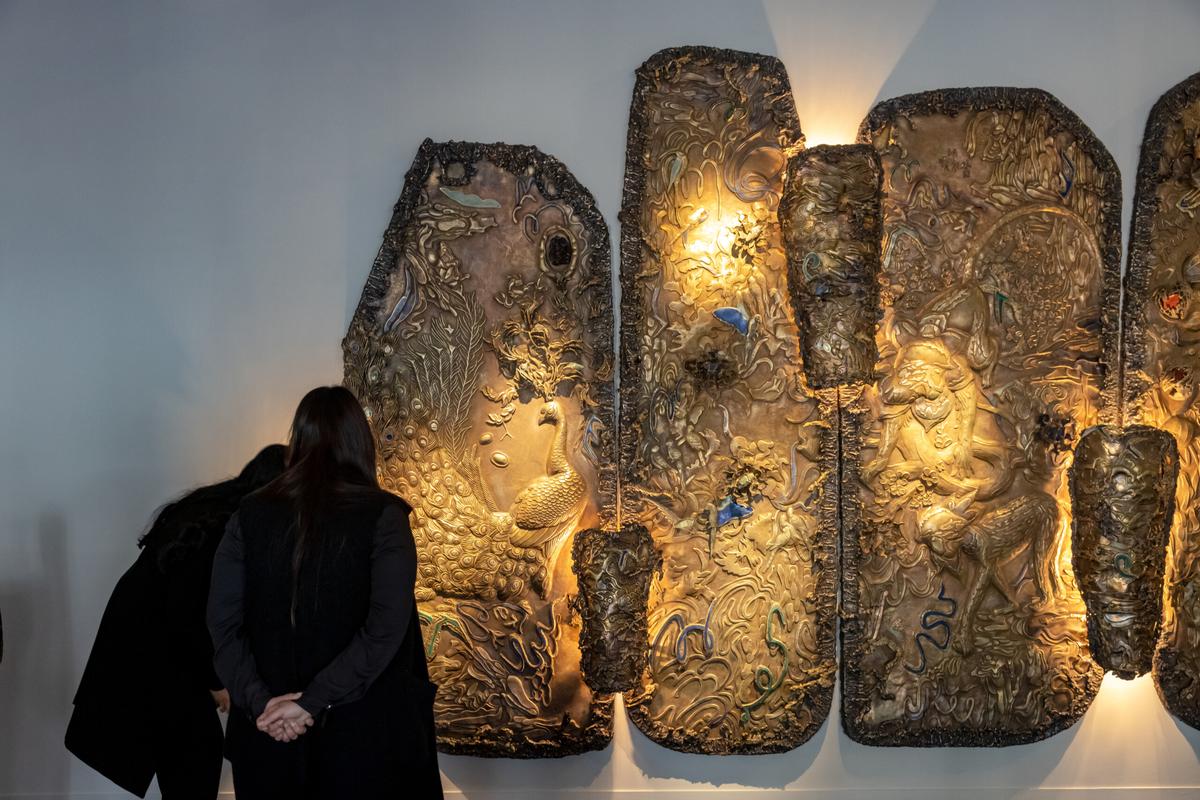
Vikram Goyal at the IAF
| Photo Credit:
Courtesy of India Art Fair
“Our job really is to expose people to different forms of art, whether it’s craft-based or design or digital art,” says IAF director Jaya Asokan, sitting at the BMW VIP Lounge, minutes before she is to join Chanakya School’s Karishma Swali to announce a major new craft prize. “The more they see it, the more openness there is to engage with and purchase it.”
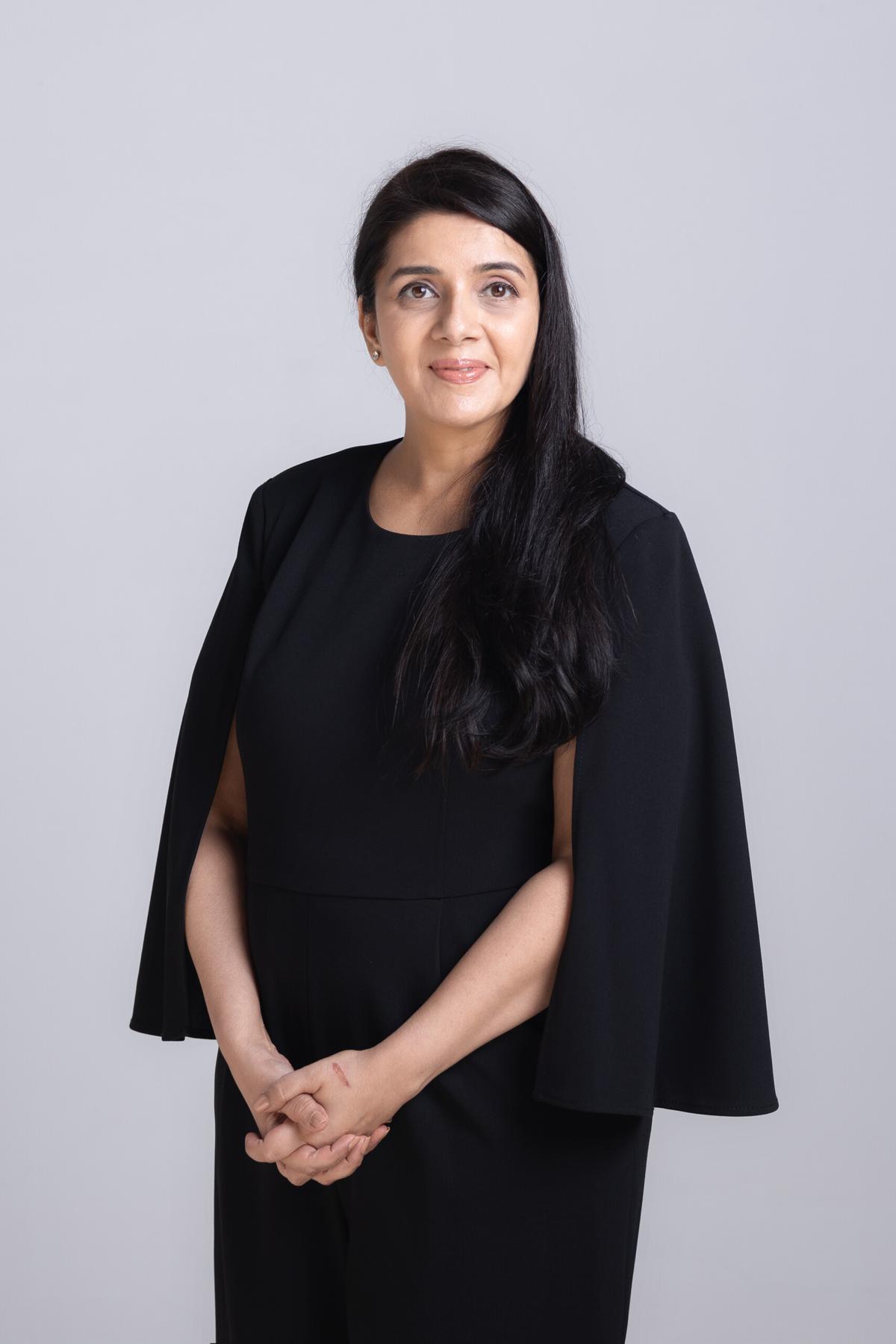
Jaya Asokan
| Photo Credit:
Courtesy of India Art Fair
Other than the democratisation of art, the commercial aspect is, naturally, the fair’s (indeed any such fair’s) primary function. The chatter around India’s thriving art and luxury market grows louder by the season — reportedly pegged at ₹3,000 crore in registered auction sales in 2023. (Hurun India’s Art List for 2024 showed a record-breaking ₹301 crore in sales by the top 50 artists — a 19% increase from the previous year.) While that’s still a fraction of the global market size of $70 billion, it’s being propelled, no doubt, by western and institutional interest in Modern masters. But who is the Indian art buyer and what do they want?
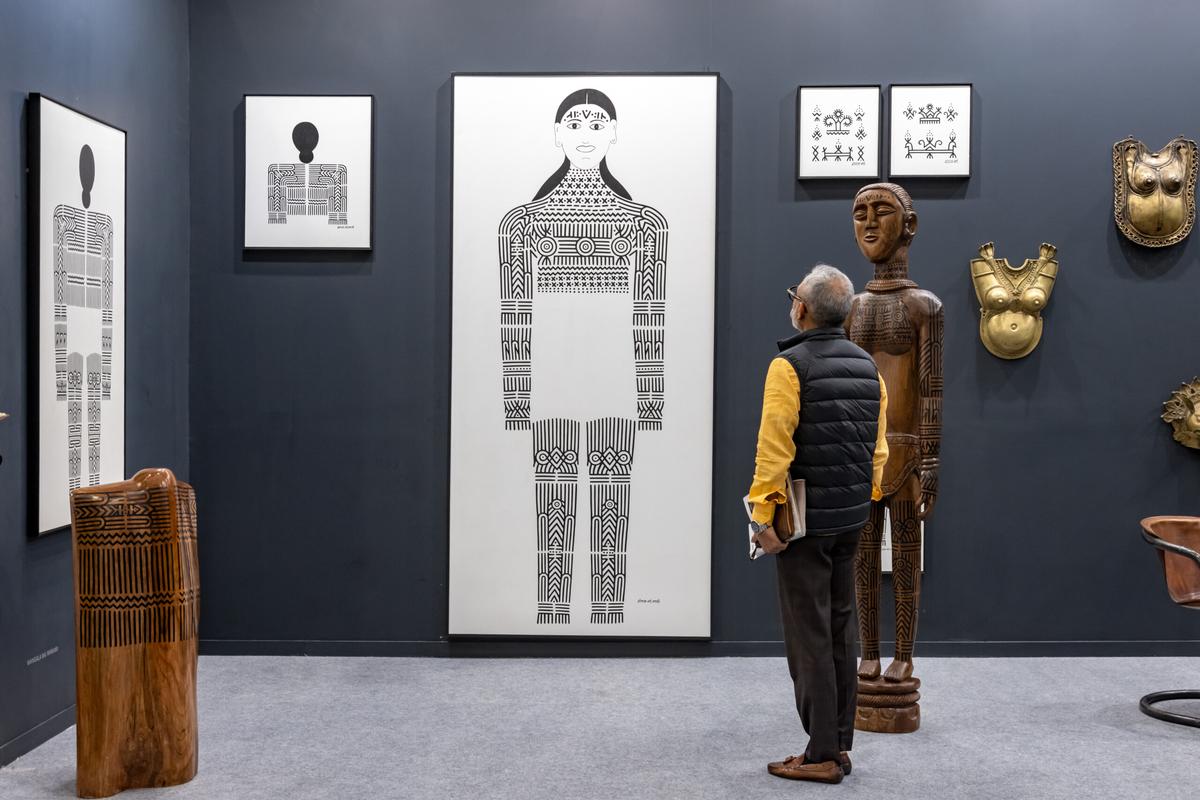
IAF 2025
| Photo Credit:
Courtesy of India Art Fair
Loyalists and younger collectors
“The Atul Dodiya shutter got a lot of attention at our booth,” says Roshini Vadehra, director of Vadehra Art Gallery. “A lot of people saw it for the first time or after many years in Delhi. The image was something that caught everyone’s eye, and people enjoyed it with a mix of fascination and humour.” She is referring to the contemporary master’s Weeping Ancestors, whose mechanically operated shop shutters roll up and down to reveal painted historical figures mourning a conflict-ridden present.
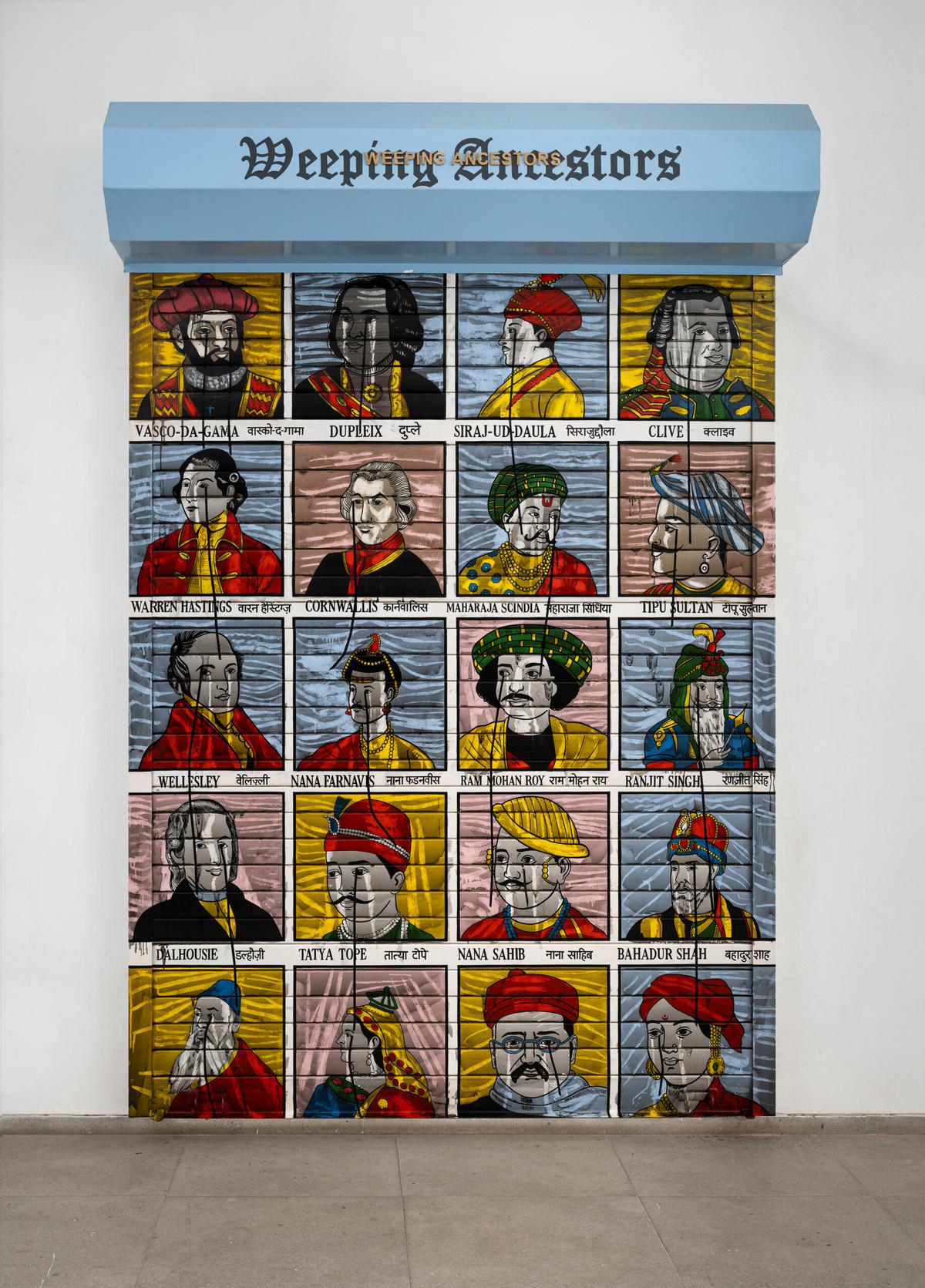
Atul Dodiya’s Weeping Ancestors
| Photo Credit:
Courtesy of India Art Fair
Vadehra Gallery sold 90% of their booth on the first day, with prices ranging from $2,500 (approx ₹2.17 lakh) to $300,000 (approx ₹2.6 crore), including works by Dodiya, Sudhir Patwardhan, Shilpa Gupta and Vivan Sundaram. “There is a mix of people buying,” she adds. “Definitely a large percentage appears to be in their 40s and 50s, but there are also a lot of younger people eager to enter the market.”
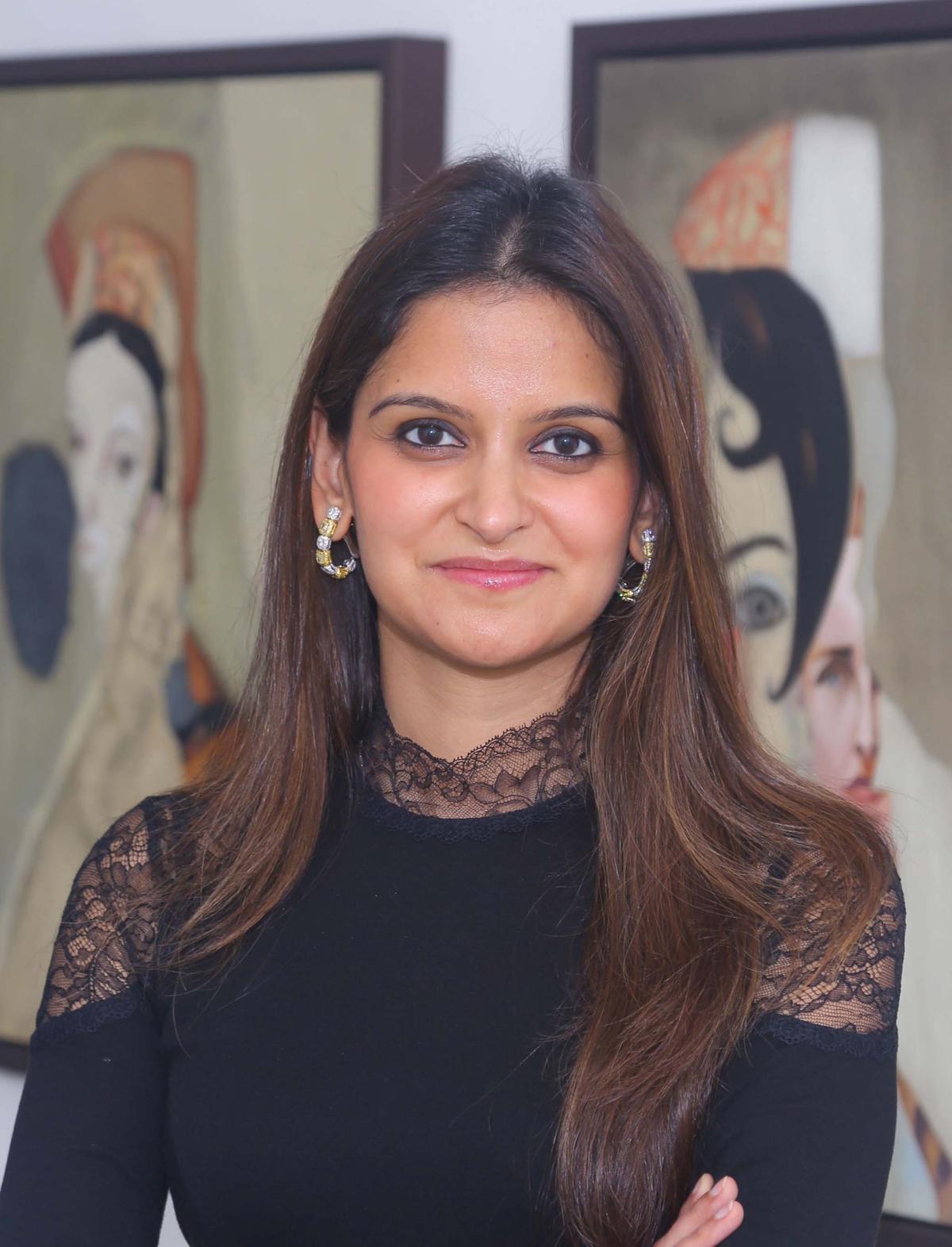
Roshini Vadehra
| Photo Credit:
Gulshan Sachdeva
Vadehra’s thoughts are echoed by Anand of DAG, who is seeing younger collectors growing in numbers, even as their loyal buyer base remains steadfast. By day three (of four), DAG “concluded healthy sales of several works with individual prices ranging between ₹40 lakh and ₹1.5 crore each… including J.P. Gangooly’s mountain landscape and a similar scene by M. Sain; S.H. Raza’s abstract set within an old window frame; Laxman Pai’s wondrously modern rendition of spring painted in Paris; Nirode Mazumdar’s imagined scene of a folkloric story from his Quest series; and Madhvi Parekh’s 1975 work, an oil on canvas board composition”.
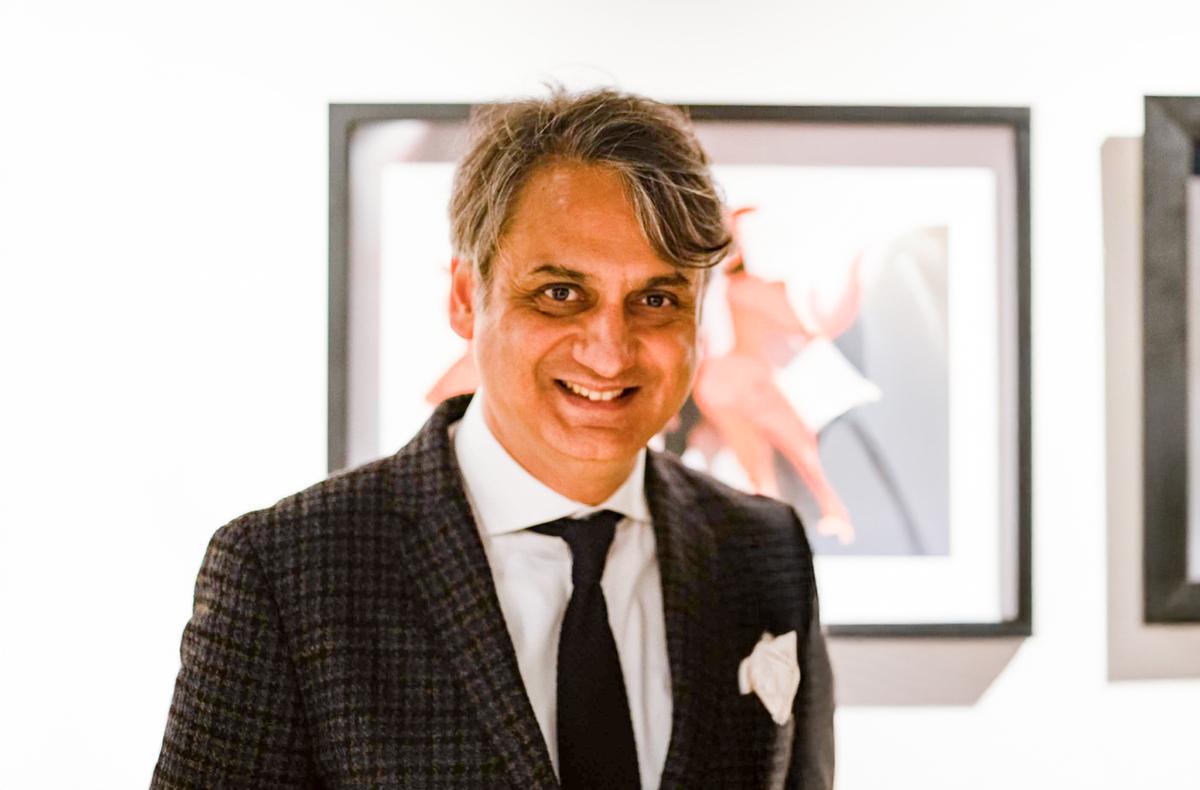
Ashish Anand of DAG
| Photo Credit:
Special arrangement
International and diasporic artists are in high demand, too. On the first day, the international gallery David Zwirner sold a painting by Zimbabwean painter Portia Zvavahera, a painting by Colombian artist Oscar Murillo, a sculpture by Pakistani-American artist Huma Bhabha, and a painting by Kochi-born artist Sosa Joseph, amongst other works.
“We’ve started representing a lot of international artists now, which would’ve earlier been a lot for Indian buyers at those price points, but now they’re buying,” says Shreemoyee Moitra, lead of exhibitions and projects at Akara gallery. At their IAF booth, Moitra enthusiastically takes visitors through the processes and origin stories of the artists represented, including U.K. sculptor Jonathan Trayte, Tokyo-born artist Keita Miyazaki, Sri Lanka-born painter Anjuna Gunarathne, and Mumbai-born New York-based sculptor and artist Tarik Currimbhoy — whose surgical steel sculpture titled Pendulum sold on day one. “We are getting a great response for younger contemporary artists from young collectors — they are looking for art that is accessible, reachable, yet good.”
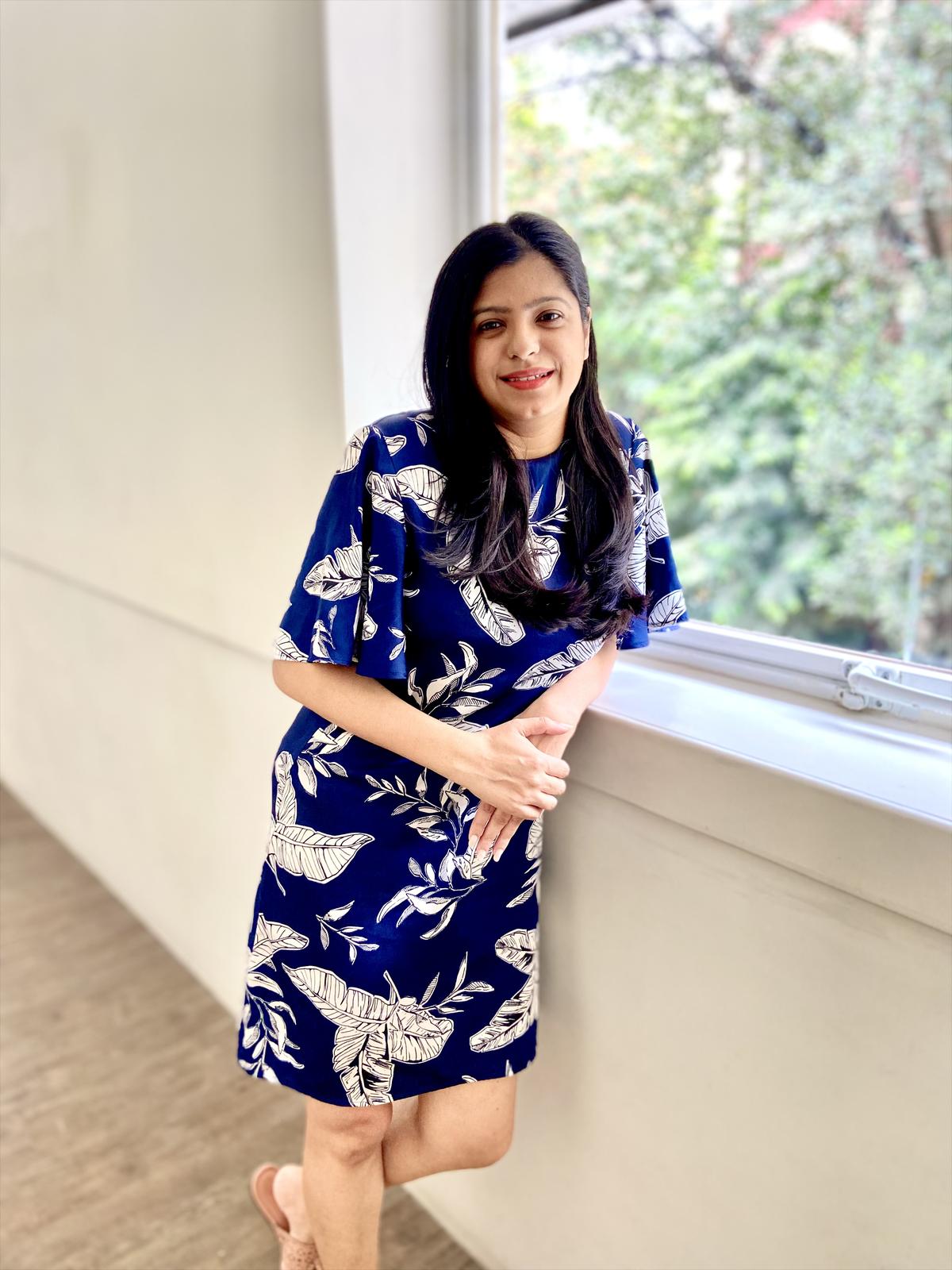
Shreemoyee Moitra, Akara gallery
| Photo Credit:
Special arrangement
The knowledgeable Indian buyer
Regardless of who they are, where they come from and what they want to buy, one thing everyone agrees upon is that the Indian art collector today is a knowledgeable, well-informed species — whether it’s a veteran collector like Kiran Nadar or a Gen Z one like Viraj Khanna.
At this year’s IAF, Nadar bought three works by the Kolkata-born contemporary artist Buddhadev Mukherjee from Art Exposure gallery — who sold a total of six works by the artist for $44,000, including one to another Indian collector, and a couple to a U.S.-based collector. “My interests have become more varied,” says Nadar, on the sidelines of opening a retrospective on the poet-painter-critic Gulam Mohammed Sheikh at her Saket museum. “For somebody who had 500 works and has grown that in the last 10-12 years to 15,000 works, it’s a few leaps forward. I’m interested in younger artists, too, but I also try to make the process of collecting an artist or a period in-depth. Be it Husain or Souza or Raza, if I had 10 works then, now I have 50-100 works. Still, if I see something, I really just go for it. I’m not normally told I’m making the wrong decision,” she laughs.
Khanna recalls that his first art acquisition was a Jayasri Burman painting, but he has since felt more drawn to younger artists with whom he can relate more, and to the things “I myself cannot do, such as a hyper-realistic painting or when someone’s doing something radically different and pushing the boundaries of art history”. He has recently acquired a Jayesh Sachdev Ganesha sculpture made with AI, and he calls himself a “big collector” of Hyderabad artist T. Venkanna’s “courageous and vulnerable” works. “I respect and value when an artist is being really brave,” he says. From IAF 2025, he’s added paintings by Indore-born 27-year-old artist Shailee Mehta and London-based 28-year-old artist Raghav Babbar. What about collectible design? “I’ve yet to research that space, so I don’t quite understand it yet.
‘Shift towards emotional and cultural value’
“Many contemporary artists may not yet have an established secondary market presence, but true collecting is not about short-term speculation,” observes Moksha Modgill, CEO of Geek Art, an Indo-Japanese gallery soon to open in the south Delhi neighbourhood of Saket.
Moksha Modgill
| Photo Credit:
Special arrangement
Their IAF booth, curated around the theme of the medium as the muse, is grabbing eyeballs for Harsha Durugadda’s sculptural series — the artist comes from a lineage of temple sculptors in Hyderabad, Thai artist Pannaphan Yodmanee’s multi-media, layered painting The Three Worlds and The Three Mothers, and Delhi-based artist Tarini Sethi’s metal sculptures. “Collecting is about building a long-term relationship with art. An artwork can become part of one’s home, family, and personal legacy — an heirloom that transcends generations. This shift towards emotional and cultural value, rather than purely financial investment, is becoming more pronounced,” adds Modgill.
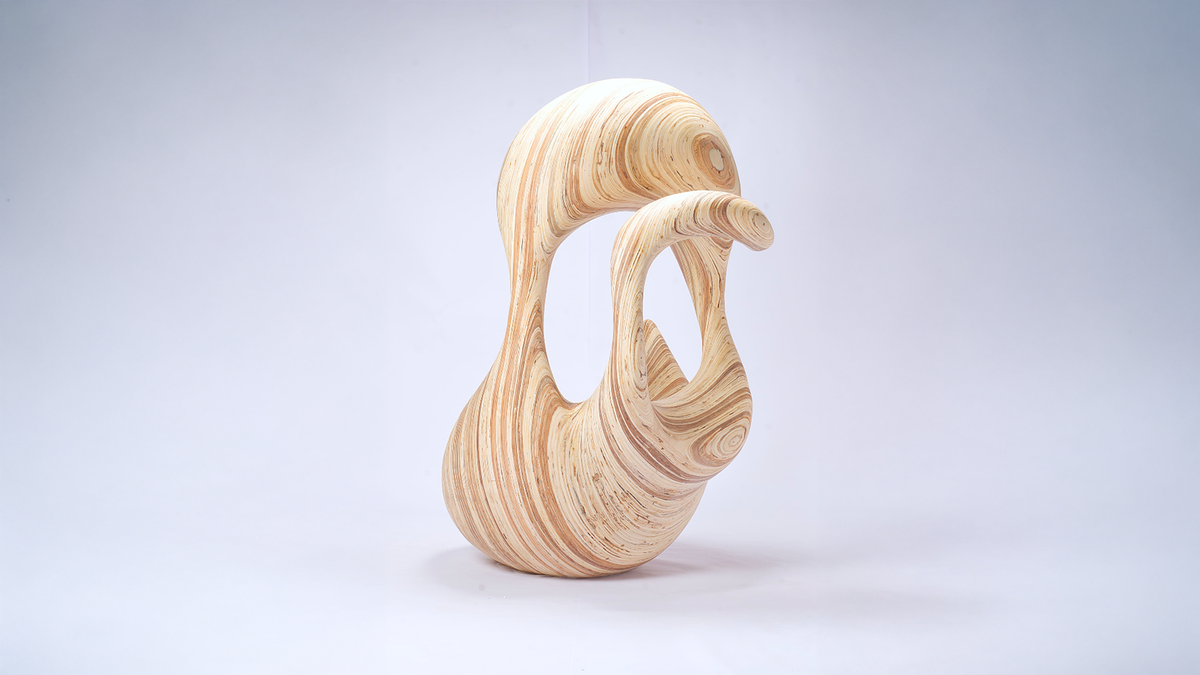
Harsha Durugadda’s Geology of Spirit
| Photo Credit:
Special arrangement
For Bhavna Kakar, director and founder of Delhi-based gallery Latitude 28, this may have something to do with the evolution in the Indian art practice itself. “There’s a growing preference for art that straddles tradition and innovation — works that incorporate unconventional materials, explore indigenous knowledge systems, or engage with socio-political themes,” she says. Take, for example, the Baroda-based artist Ketaki Sarpotdar, patiently taking every curious visitor who found themselves arrested by her large-scale painting on the exterior wall of Latitude 28’s booth, through her process of layering metaphors from Panchatantra and Tulu folk tales to unpack her enduring fascination with crowd psychology.
Latitude 28’s booth
“Collectors today are more willing to take risks, investing in experimental practices rather than purely aesthetic or decorative works,” says Kakar, adding that Sarpotdar’s work was bought by a museum (undisclosed) for ₹22 lakh. “Regional diversity is also becoming more evident, with interest growing beyond the traditional metropolitan hubs of Delhi and Mumbai to include buyers from cities like Hyderabad, Ahmedabad and Kochi.”
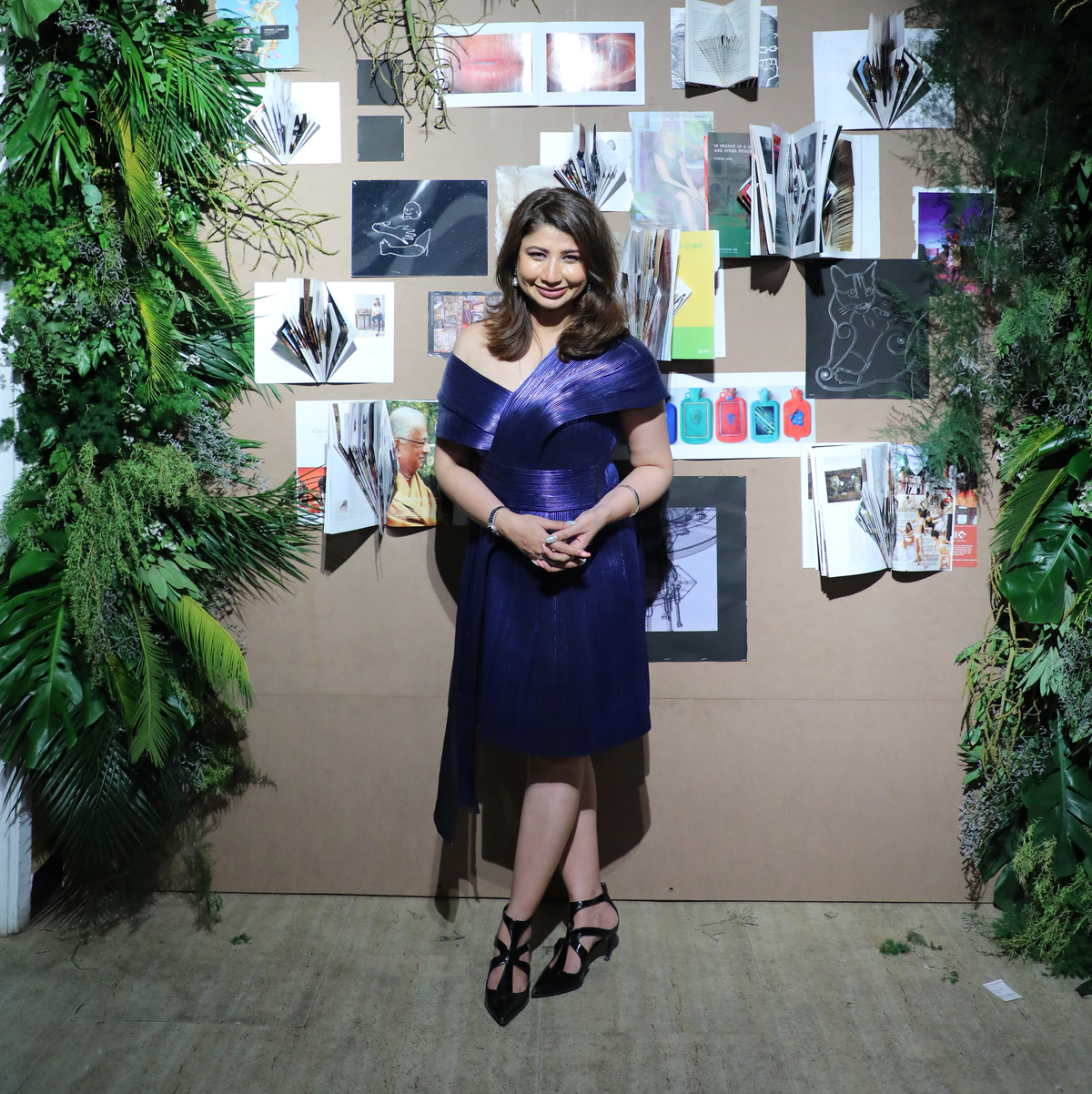
Bhavna Kakar
| Photo Credit:
Special arrangement
But as far as fairs are meant to be hubs to court new buyers, Ashvin Rajagopalan, founder of the Chennai-based gallery Ashvita’s, feels that he hasn’t met enough people outside of the Indian art community at the IAF. “The irony is that people from Chennai who wouldn’t make the effort to come to the gallery, are coming here and buying,” he says with a grimace, as he rests his feet after a long day of walks and talks on day two of IAF. “We’ve done well, but we’re selling because we’re bringing something different, something people are not used to, or not expecting to see.”
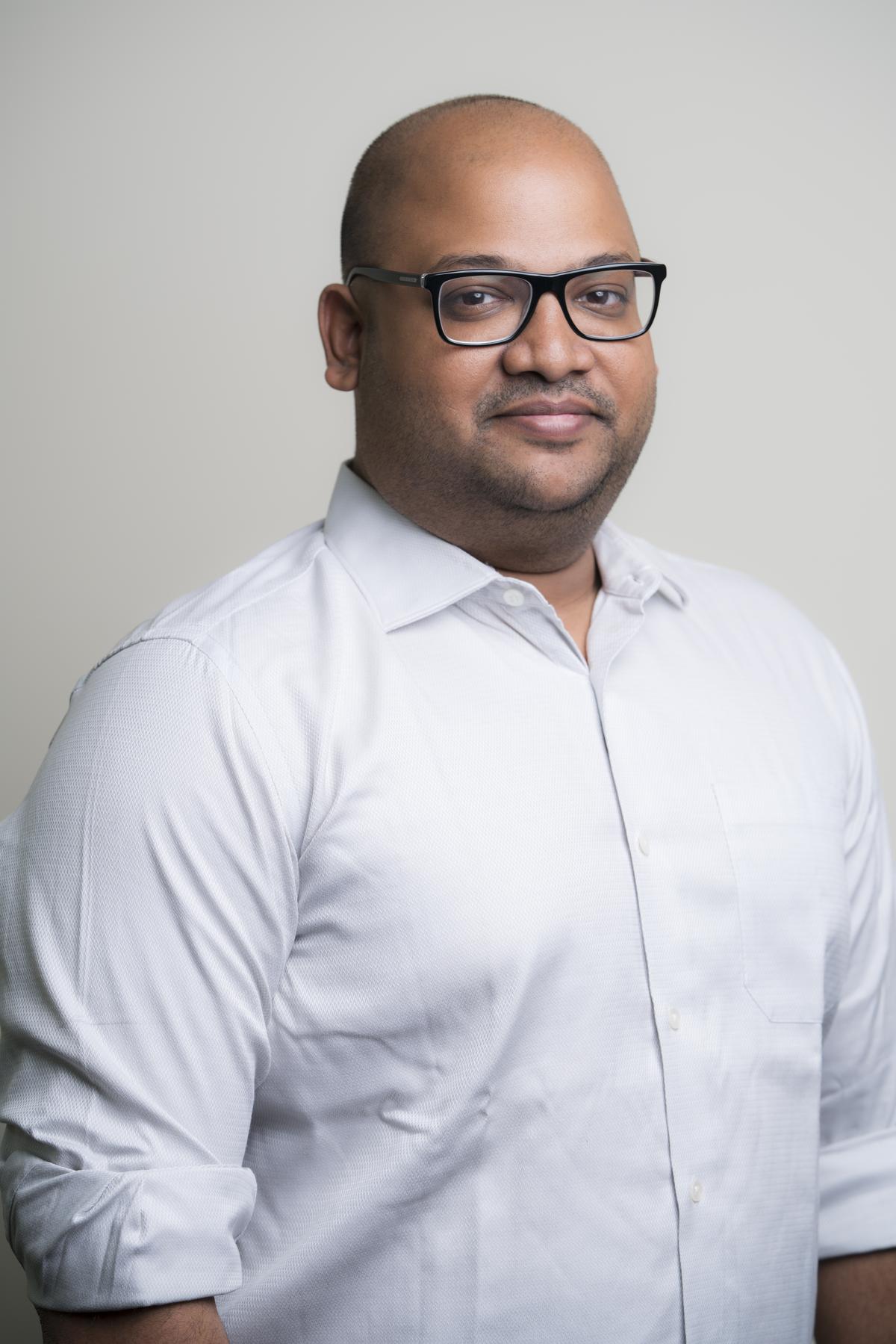
Ashvin Rajagopalan
| Photo Credit:
Special arrangement
Ashvita’s debuted at IAF this year with ‘The Madras Line’, an academically inclined show on the Madras Art Movement begun by D.P. Roy Choudhury in 1929, and traced through his students and later teachers at the Madras School of Art, including select works by S. Dhanapal, K.C.S. Paniker and R. Krishna Rao, among others. By the end of the fair, Ashvita’s sold five works by Choudhury to a Mumbai-based collector for $69,000.
Market for collectibles
“Home is at the heart and centre of lifestyle at the moment — a post-COVID phenomenon globally,” observes Mumbai-born Gunjan Gupta, whose design practice has spanned 20 years, and who was at IAF 2025 with Continuum I, where totem poles and vases in the shape of Mohenjo-daro dancing dolls were a big hit. “There was no Indian design here or abroad in 2006 when I started. In this time, the evolution has been incredible and significant. We are at a very interesting moment in time — Indians are proud to be Indians in a new way.”
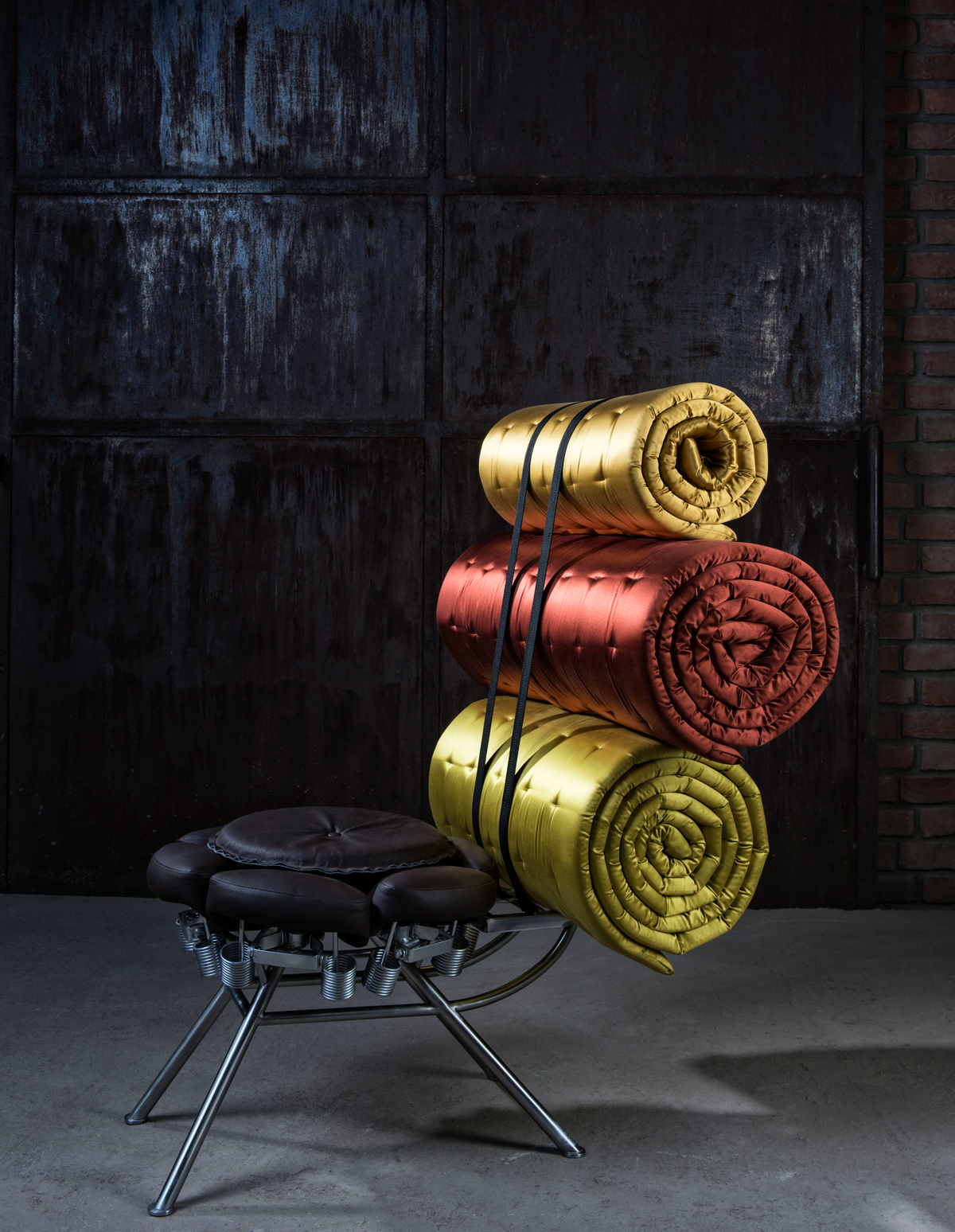
A Gunjan Gupta collectible
| Photo Credit:
Courtesy of Gunjan Gupta
The numbers speak to a vibrant market for collectible design indeed. New York-based Carpenter’s Workshop made sales worth $600,000 (approx ₹5.2 crore) at IAF, and Gujral’s Shifting Horizons pulled in a total of ₹60-₹70 lakh with popular products such as lamps by Creatomy, Jhankar’s partition screen and Sharol Ahluwalia’s Kundalini stools. “95% were Indian, 40+ buyers who are design conscious and were looking to add statement pieces to their homes,” she shares.
Art for every pocket
Inside the IAF tents, sales remain brisk throughout the four days. Nature Morte sold 70% of their booth by the second day, including a Jitish Kallat for around $100,000; Iram Gallery sold works by Promiti Husain and Sangeeta Sandrasegar, as well as a large work by Dinar Sultana, to an Indian collector for $24,000; Shrine Empire sold two works by Nandita Kumar for over $30,000 each and multiple smaller works at the $10,000 price point.
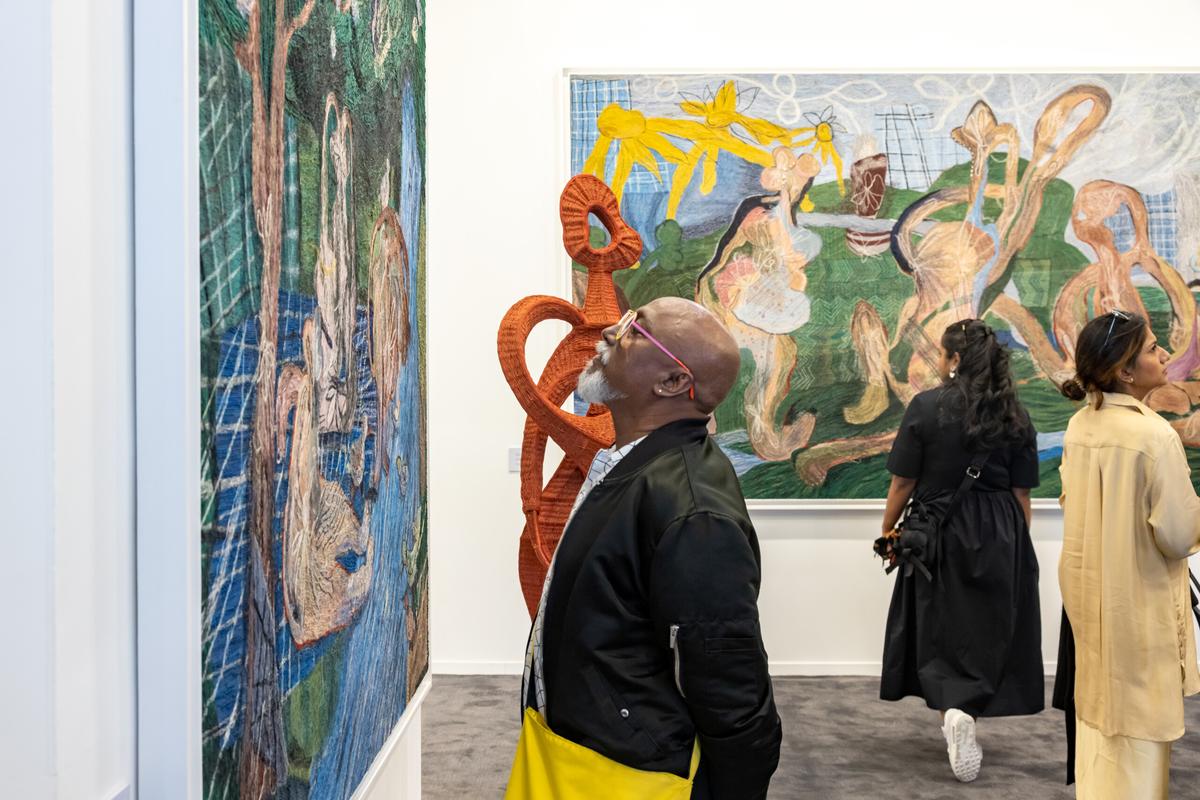
Artist and curator Bose Krishnamachari at the Chanakya School of Craft exhibit
| Photo Credit:
Courtesy of India Art Fair
Still more affordable are the limited edition prints of Modern masters at Archer Art Gallery. “In the 1980s, artists like Husain and Raza had the foresight that one day their work might be too expensive to own, so they decided to produce these limited-edition, hand-signed prints,” says Manan Relia. “And now people realise that there’s value in this too — and a fine example of that is Picasso’s prints, which would sell for $50 in his lifetime. Now you can’t get your hands on anything for less than $50,000.”
“There’s a strong interest in art,” observes Anand, “but equally art is being seen as something people want to identify with. India is poised to become an art superpower and we’re seeing this interest accelerating.” This is clearly evident by sundown on the opening day — the wine’s begun to flow, the electronic music and chatter are getting louder, and the queues outside M. Pravat’s installation I Don’t Want You To See This are getting longer. “I was really drawn to the textile art at the fair,” says a Delhi-based graphic designer, who is now working on her own skincare brand. “I may not buy anything, but it’s amazing — there’s art for every kind of pocket here.”
The writer is an independent journalist based in Mumbai, writing on culture, lifestyle and technology.
Published – February 14, 2025 11:50 am IST


